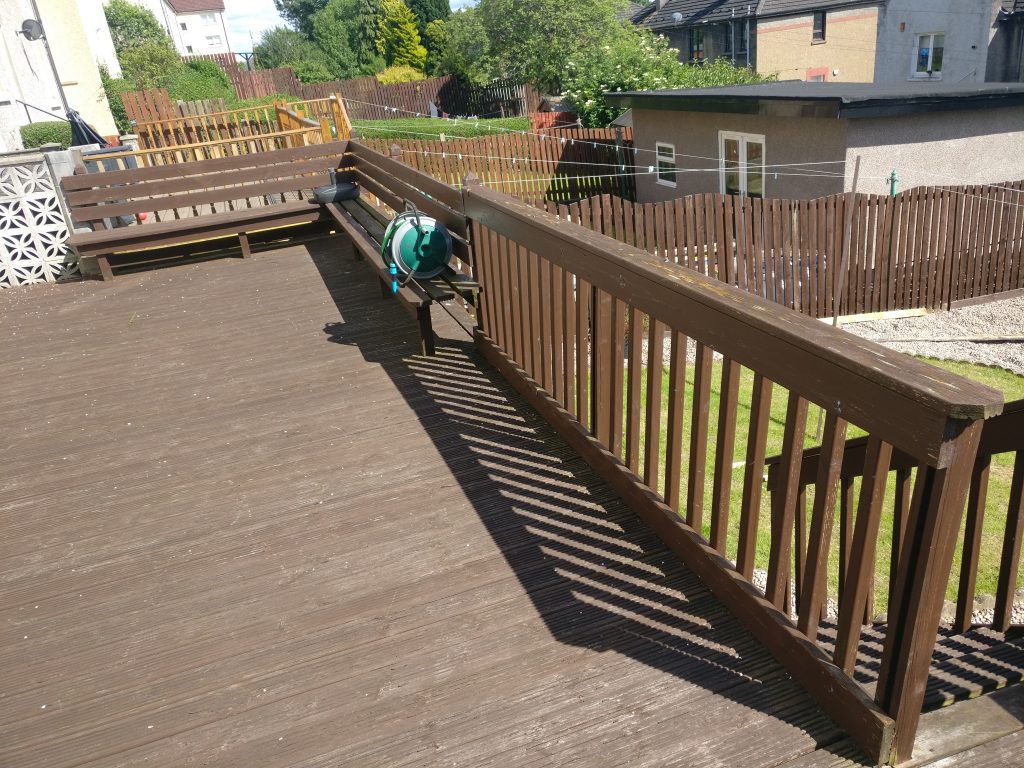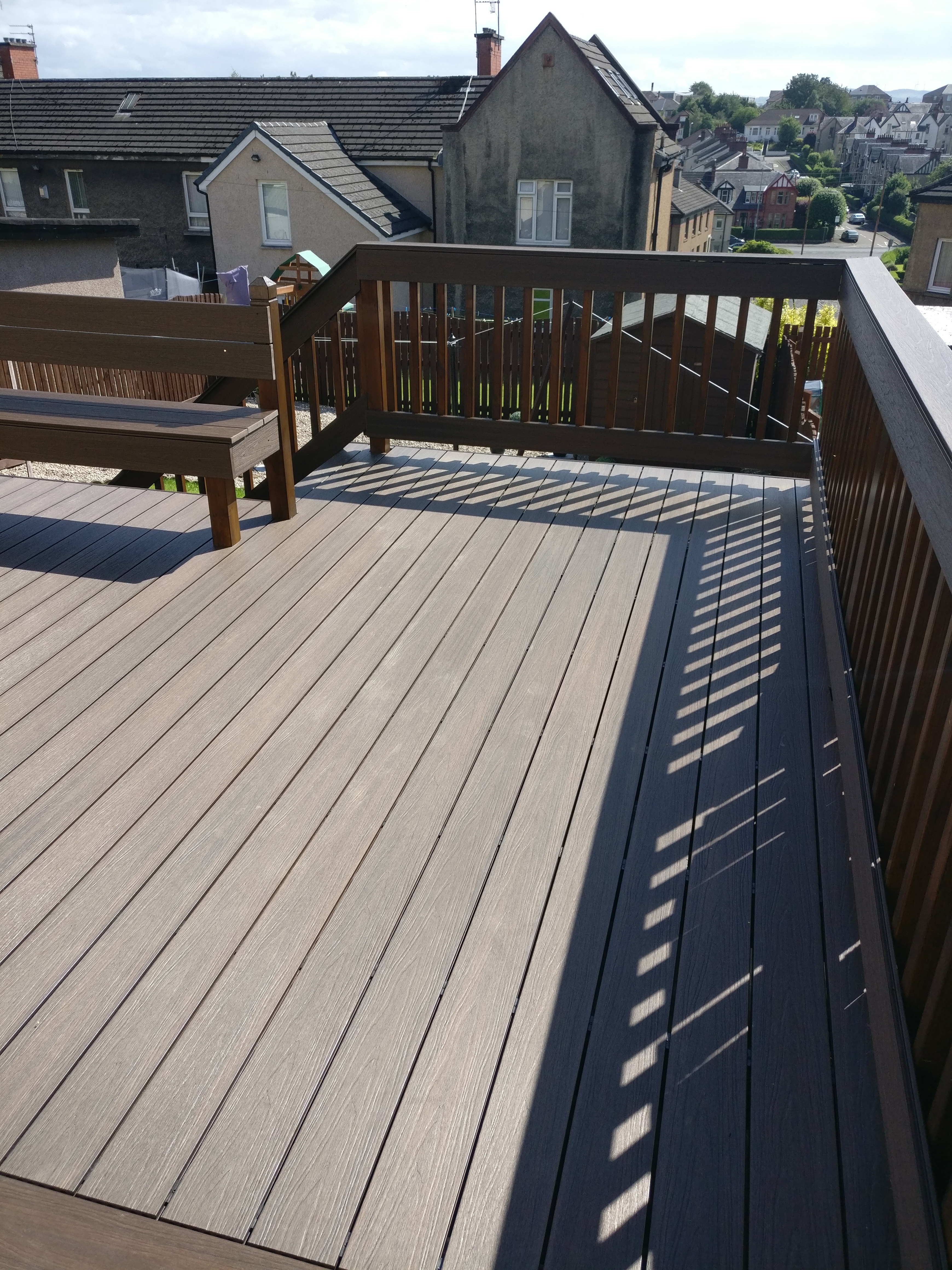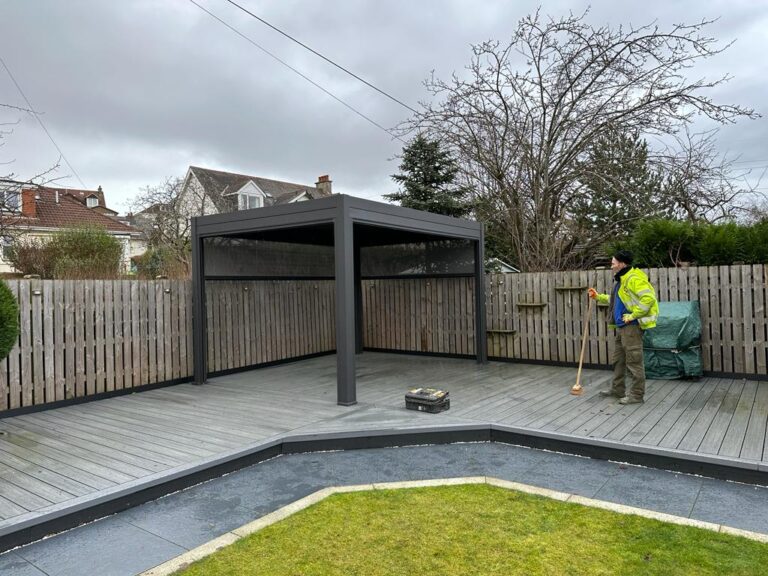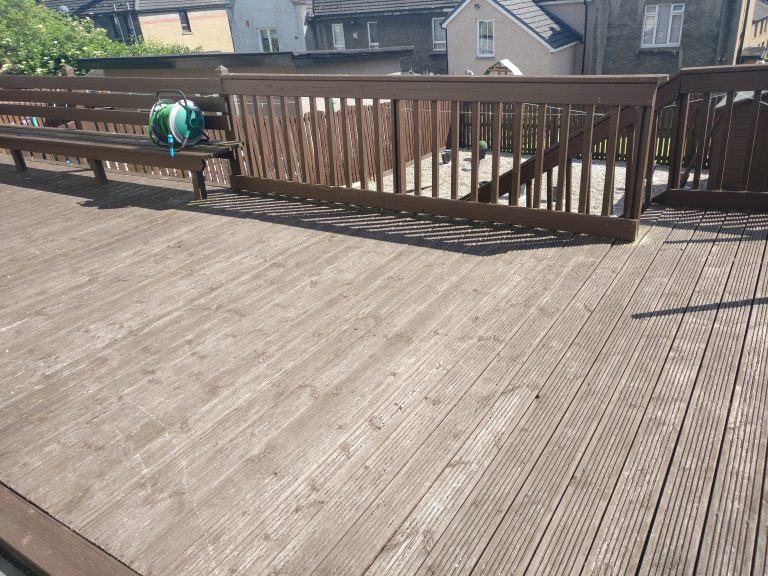Composite decking can be a great choice, but can it get mouldy? It depends on the material and care. It’s made of wood fiber, plastic, and binders. This makes it more resistant to mould than natural wood. However, organic matter like leaves or debris left on the deck could cause mould. Cleaning and maintenance can help, like sweeping or hosing off organic matter.
Also, good airflow is important for preventing moisture buildup. If your deck has limited air circulation, use fans or add vents. To clean mould from composite decking, use mild products like warm water and soap with a soft brush or cloth. Avoid harsh chemicals and abrasive scrubbers.
For extra protection, apply a mould-inhibiting treatment. This creates a protective barrier against mould spores.

What is composite decking?
Composite decking is an innovative substitute for traditional timber decking, which has become popular in recent times. It is a combination of wood fibers and recycled plastic materials, mixed together to form a durable and low-maintenance decking solution.
- It is resistant to rot and decay, making it the best option for outdoor structures.
- It is less prone to warping, cracking, and splitting, compared to regular wooden decking.
- Moreover, its sleek and modern look adds an appealing touch to any outdoor area.
- Unlike natural wood, composite decking does not need frequent staining or painting, saving you from time-consuming maintenance.
You can even choose from a variety of colors and finishes to customize your outdoor space according to your preference. Installing the material is simple and can be done with standard woodworking tools, making it suitable for DIYers and professional builders alike.
Pro Tip: To stop mould growth on composite decking, make sure it is routinely washed with mild soap and water. Additionally, ensure good drainage in the nearby regions to avoid excessive moisture accumulation.
The benefits of composite decking
Composite decking is a great option for outdoor spaces. It is highly durable, since it is made of a mix of wood fibres and plastic. This means it can take on any weather without rotting, warping, or cracking. Plus, it requires little maintenance. No need to stain or seal it regularly. Plus, it stays good-looking for years, as it resists fading and staining.
The eco-friendly nature of composite decking is another plus. Many boards are made from recycled materials, like plastic bags and sawdust. This helps cut down on the demand for virgin timber, protecting forests. And, it does not need harsh chemicals, as compared to natural wood decks.
Design options are plentiful! There’s a composite decking style to match every taste, from natural wood to modern. With a range of colours and finishes, you can easily find a look that suits your outdoor space.
Pro Tip: To keep your composite decking looking great, ensure proper ventilation by leaving gaps between boards for air circulation. Clean the surface regularly with mild soap and water, or use products specifically designed for composite decking.
Common concerns about composite decking
Composite decking is a popular choice for outdoor spaces due to its durability and low maintenance. However, there are some common concerns that people have about composite decking. Let’s address these concerns and provide some helpful suggestions.
Firstly, one common concern is whether composite decking can go mouldy. The answer to this is no, composite decking does not typically go mouldy. This is because it is made from a mixture of wood fibers and recycled plastic, which are resistant to mould and mildew. However, it is still important to maintain your decking by keeping it clean and free from debris, as this can help prevent the growth of mould and mildew.
Another concern is whether composite decking is prone to fading. While all outdoor materials are subject to some degree of fading over time due to exposure to the elements, composite decking is designed to be resistant to fading. Most composite decking products have built-in UV protection to help prevent fading and maintain their color for longer.
Some people also worry about composite decking being too hot to walk on during sunny days. While it is true that composite decking can get warm in direct sunlight, it is not significantly hotter than traditional wooden decking. The heat dissipates quickly once the sun goes down or when shaded areas are created. To further mitigate this issue, you can choose lighter-colored composite decking or opt for a shade structure to provide relief from the sun.
Another concern is the appearance of scratches on composite decking. While composite decking is highly durable, it is not completely scratch-proof. However, minor scratches can often be easily repaired by using a deck repair kit or by gently sanding the affected area. To prevent scratches in the first place, it is recommended to use furniture pads or coasters under heavy outdoor furniture and to avoid dragging sharp objects across the surface.
In addition to these common concerns, it is worth mentioning that composite decking is an environmentally friendly choice. By using recycled materials, composite decking helps to reduce the demand for new wood and plastic, thereby conserving natural resources.
Does composite decking go Mouldy? Well, if you’re looking for a deck that parties harder than Charlie Sheen, then yeah, it might get a little moldy.

Does composite decking go Mouldy?
Composite decking has mould and mildew resistance due to its blend of wood fibers and recycled plastic, plus reduced moisture absorption. Here are some fab facts about this:
- It’s made of a mix of wood fibers and recycled plastic, making mould growth less likely.
- The plastic acts as a moisture barrier, avoiding mould.
- Unlike traditional timber, composite does not provide food for mould spores.
- It absorbs less moisture, so won’t be a breeding ground for mould.
- Regular cleaning and maintenance can stop mould growth.
- High quality composite from reliable makers offers superior mould protection.
Plus, composite decking has loads of other advantages like durability, low maintenance, and colour retention. It’s a great long-term pick for anyone wanting an eye-catching, long-lasting outdoor flooring solution.
Quick Tip: Clean with warm, soapy water or composite deck cleaner once or twice a year to keep your composite decking looking fab and to prevent any build-up that could create mould.
Factors that contribute to mould growth on composite decking
Mould growth on composite decking is a reality, but understanding its contributing factors can help with maintenance. Things like moisture, poor ventilation, organic matter, lack of sunlight and improper installation are all at play. Regularly inspecting and cleaning surfaces is also key. The EPA says high indoor humidity can lead to mould growth on any surface.
Preventing mould growth on composite decking
Mould growth on composite decking can be prevented with proper care and maintenance. Taking the necessary steps will ensure that your decking remains mould-free and looking its best.
To prevent mould growth on composite decking, follow these steps:
- Regular Cleaning: Regularly clean your composite decking to remove dirt, debris, and organic matter that can promote mould growth. Use a mild detergent, water, and a stiff brush to scrub the surface. Avoid using abrasive cleaners or tools that can damage the decking material.
- Proper Ventilation: Ensure that your composite decking has proper ventilation to prevent moisture buildup. Good airflow helps to keep the surface dry and discourage mould growth. Avoid covering the decking with rugs or furniture that can trap moisture underneath.
- Apply a Protective Coating: Consider applying a protective coating to your composite decking to further prevent mould growth. There are specific coatings available that can add an extra layer of protection against mould and mildew. Consult with the manufacturer or a professional for the best coating option for your decking.
It’s important to note that composite decking is designed to be resistant to mould and mildew, but it is not completely immune. Taking these preventative measures will greatly reduce the chances of mould growth and keep your decking in excellent condition.
In addition to regular maintenance, it’s crucial to recognize the historical significance of mould growth on composite decking. In the past, many homeowners struggle to prevent mould growth, leading to unsightly and potentially hazardous conditions on their decks. However, with advancements in decking technology and increased awareness of proper care, it is now easier for homeowners to keep their composite decking mould-free and aesthetically pleasing.
By following these steps and staying proactive in the maintenance of your composite decking, you can enjoy a beautiful outdoor space without the worry of mould growth.
Let’s face it, composite decking may look nice, but without regular cleaning and maintenance, it becomes the perfect breeding ground for mold, turning your beautiful outdoor oasis into a tiny ecosystem of its own!
Regular cleaning and maintenance
Keep your composite decking looking its best with four easy steps!
- Firstly, remove any loose dirt or debris using a broom or leaf blower.
- Secondly, mix a solution of warm water and mild detergent in a bucket.
- Thirdly, scrub the surface of your decking with the soapy water.
- Lastly, rinse off the soapy water with clean water.
To prevent mould from reoccurring, consider applying an anti-mould treatment or sealant after cleaning. In addition, inspect your decking for any signs of damage or wear and replace any damaged boards promptly. With regular cleaning and maintenance, your composite decking will reward you with years of enjoyment!
Proper ventilation and drainage
Proper ventilation and drainage is key to preventing mould growth on composite decking. Without these, moisture can build and cause mould and mildew. Consider the following points for good ventilation and drainage:
- Create gaps between boards. This avoids air pockets which promote mould.
- Install vents or fans near the deck for air flow and to avoid moisture buildup.
- Make sure downspouts and gutters point away from the deck, so water doesn’t pool.
- Clear debris like leaves and dirt from gaps between boards, for good drainage.
- If your deck is over a flat surface, use a sloped substructure for rainwater to drain effectively.
Note: Composite decking materials differ in porosity and moisture resistance. Check with the manufacturer or a professional for proper ventilation and drainage guidelines.
Pro Tip: Regularly inspect your deck for mould or mildew signs like discoloration or musty odors. Early detection allows for prompt action and less damage.
By following these steps, you can ensure good ventilation and drainage for your composite decking, prevent mould growth and keep its durability and looks.
Steps to remove mould from composite decking
Removing mould from composite decking can be tricky, but with the right steps, it can be done. Check out this guide to help you take on the issue and restore your deck.
- Step 1: Find the affected areas. Inspect your composite decking for any signs of mould growth. Look for dark spots or discolored patches. Once found, mark those areas to focus your cleaning efforts.
- Step 2: Make a cleaning solution. Put warm water and mild soap in a bucket. Don’t use bleach or harsh chemicals, as they damage the composite material. Stir until the soap is dissolved.
- Step 3: Clean and scrub the marked areas. Dip a soft-bristle brush or mop into the cleaning solution and scrub the mouldy spots on your decking. Apply gentle pressure to remove dirt and mould without causing damage. Be sure to cover all the marked areas.
After scrubbing, rinse off the cleaning solution with clean water. Use a garden hose or power washer set at low pressure.
Prevention is key when it comes to mould growth on composite decking. Sweep away debris, leaves, and other organic matter. Regularly doing this prevents moisture buildup, which leads to mould formation.
Apply an anti-mould treatment for composite decking. This provides an extra layer of protection against future mould growth.
Maintain cleanliness and take proactive measures to keep your composite decking free from mould and extend its lifespan.
Composite decking is resistant to rotting and decay due to its composition of recycled wood fibers and plastic materials. Experts at The Decking Superstore confirm this.
Conclusion
No mould on composite decking! It’s a mix of wood and plastic, so it’s really tough against mould. That’s why it’s great for outdoor spaces – it can take all the weather without getting ruined. Not much maintenance too, so less chance of mould growth. Perfect if you want a durable, low-maintenance option.
Not only is it mould-resistant, but there’s more! Composite decking has no splinters, and it’s slip-resistant. So it’s safe to walk on in any weather. Also, it won’t fade or stain. Plus, loads of colours and finishes to make your outdoor space look amazing.
Plus, eco-friendly too! Made with recycled materials, so it stops waste going to landfills. And no need for staining or painting treatments. So it’s better for the environment and for your wallet!
Choose composite decking now for a beautiful, hassle-free outdoor experience. Tip: Clean your composite deck with soap and water to keep it looking great, and stop mould growth.
Frequently Asked Questions
Frequently Asked Questions about Mould on Composite Decking
Q: Does composite decking go mouldy?
A: Composite decking is resistant to mould and mildew growth due to its durable and non-porous surface. However, if the deck is consistently exposed to moisture and organic debris, mould can develop. Regular cleaning and maintenance can prevent mould growth on composite decking.
Q: How can I prevent mould on my composite decking?
A: To prevent mould on composite decking, ensure proper ventilation to allow for drying and minimise moisture accumulation. Regularly sweep away leaves, dirt, and debris. Clean the deck with a mild soap and water solution or a recommended composite deck cleaner. Avoid using bleach or pressure washers as they may damage the deck’s surface.
Q: Can I use bleach to remove mould from composite decking?
A: It is not recommended to use bleach on composite decking as it can discolour the deck and damage the surface. Instead, use a composite deck cleaner specifically formulated to remove mould and mildew stains. Follow the manufacturer’s instructions for the best results.
Q: How often should I clean my composite decking?
A: It is recommended to clean your composite decking at least once or twice a year. However, if you notice mould or mildew growth, clean the deck as soon as possible to prevent further spread. Regularly removing debris and keeping the deck dry can help reduce the frequency of cleaning.
Q: Can I power wash my composite decking to remove mould?
A: While power washing may remove mould from composite decking, it is generally not recommended. High-pressure water can damage the deck’s surface and lead to moisture penetration, which can promote mould growth. Consult the manufacturer’s guidelines before using a power washer and use it at the lowest pressure setting if approved.
Q: Are there any preventive measures I can take to stop mould growth on composite decking?
A: Yes, you can take preventive measures to stop mould growth on composite decking. Ensure proper spacing between boards for adequate air circulation. Remove any standing water or wet leaves promptly. Install a gutter system or downspouts to redirect water away from the deck. Regularly inspect the deck for any signs of mould or moisture accumulation and take immediate action to address them.
{
“@context”: “https://schema.org”,
“@type”: “FAQPage”,
“mainEntity”: [
{
“@type”: “Question”,
“name”: “Does composite decking go mouldy?”,
“acceptedAnswer”: {
“@type”: “Answer”,
“text”: “Composite decking is resistant to mould and mildew growth due to its durable and non-porous surface. However, if the deck is consistently exposed to moisture and organic debris, mould can develop. Regular cleaning and maintenance can prevent mould growth on composite decking.”
}
},
{
“@type”: “Question”,
“name”: “How can I prevent mould on my composite decking?”,
“acceptedAnswer”: {
“@type”: “Answer”,
“text”: “To prevent mould on composite decking, ensure proper ventilation to allow for drying and minimise moisture accumulation. Regularly sweep away leaves, dirt, and debris. Clean the deck with a mild soap and water solution or a recommended composite deck cleaner. Avoid using bleach or pressure washers as they may damage the deck’s surface.”
}
},
{
“@type”: “Question”,
“name”: “Can I use bleach to remove mould from composite decking?”,
“acceptedAnswer”: {
“@type”: “Answer”,
“text”: “It is not recommended to use bleach on composite decking as it can discolour the deck and damage the surface. Instead, use a composite deck cleaner specifically formulated to remove mould and mildew stains. Follow the manufacturer’s instructions for the best results.”
}
},
{
“@type”: “Question”,
“name”: “How often should I clean my composite decking?”,
“acceptedAnswer”: {
“@type”: “Answer”,
“text”: “It is recommended to clean your composite decking at least once or twice a year. However, if you notice mould or mildew growth, clean the deck as soon as possible to prevent further spread. Regularly removing debris and keeping the deck dry can help reduce the frequency of cleaning.”
}
},
{
“@type”: “Question”,
“name”: “Can I power wash my composite decking to remove mould?”,
“acceptedAnswer”: {
“@type”: “Answer”,
“text”: “While power washing may remove mould from composite decking, it is generally not recommended. High-pressure water can damage the deck’s surface and lead to moisture penetration, which can promote mould growth. Consult the manufacturer’s guidelines before using a power washer and use it at the lowest pressure setting if approved.”
}
},
{
“@type”: “Question”,
“name”: “Are there any preventive measures I can take to stop mould growth on composite decking?”,
“acceptedAnswer”: {
“@type”: “Answer”,
“text”: “Yes, you can take preventive measures to stop mould growth on composite decking. Ensure proper spacing between boards for adequate air circulation. Remove any standing water or wet leaves promptly. Install a gutter system or downspouts to redirect water away from the deck. Regularly inspect the deck for any signs of mould or moisture accumulation and take immediate action to address them.”
}
}
]
}








